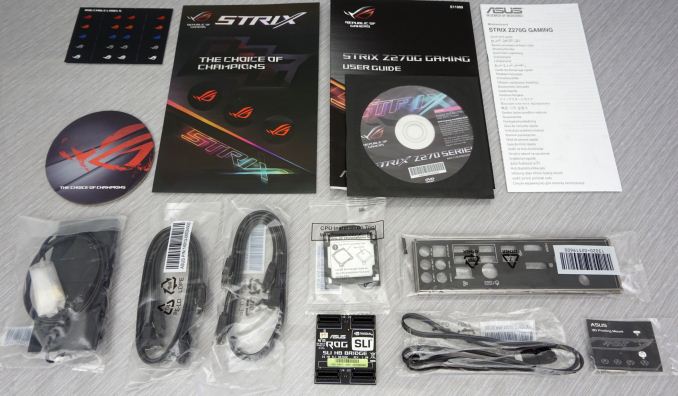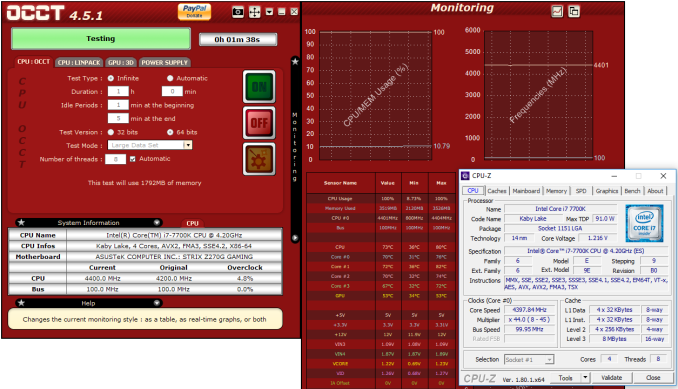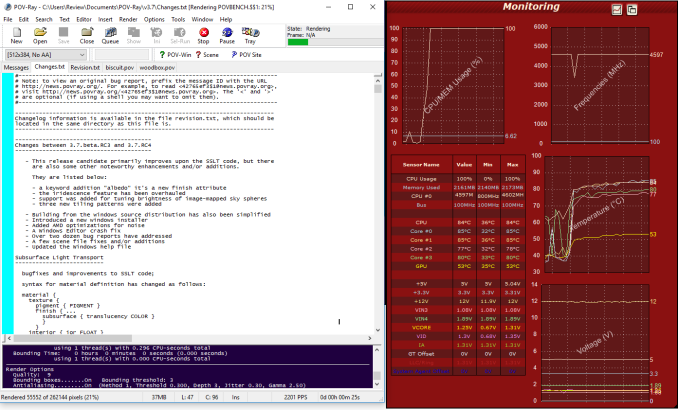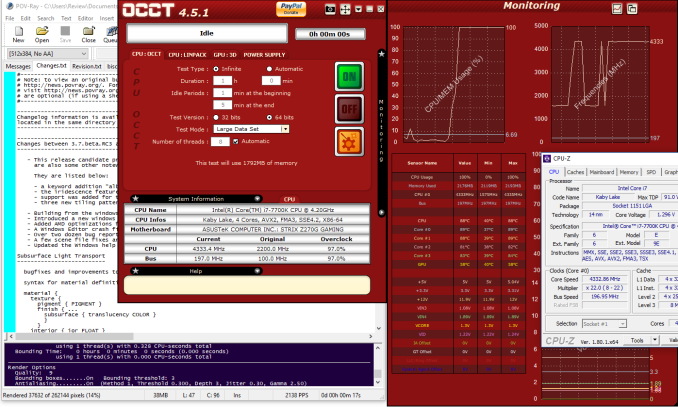The Asus ROG Strix Z270G Gaming Motherboard Review
by E. Fylladitakis on October 3, 2017 8:15 AM ESTAsus ROG Strix Z270G Gaming Board Features
If a look at its name is not conclusive enough, a simple glance either on the motherboard’s box or at the manufacturer’s website instantly reveals that the Asus ROG Strix Z270G Gaming is a product directly marketed towards gamers. Everything about the motherboard, from its color and down to its last feature, was a design choice with gamers in mind. The highlight of the ROG Strix Z270G Gaming probably is its two full-length PCIe slots that allow for SLI/Crossfire configurations. Asus also tried to make this motherboard as easy to work with as possible by installing a lot of tools that automate overclocking/tweaking procedures, allowing less experienced users to easily boost the performance of their systems.
| Asus ROG Strix Z270G Gaming | |
| Warranty Period | 3 Years |
| Product Page | Link |
| Price | Link |
| Size | ATX |
| CPU Interface | LGA1151 |
| Chipset | Intel Z270 |
| Memory Slots (DDR4) | Four DDR4 Supporting 64GB Dual Channel Up to 3733+ MHz |
| Memory Slots (DDR3L) | None |
| Video Outputs | HDMI 1.4a DisplayPort 1.2 |
| Network Connectivity | 1 x Intel I219-V 1 x Qualcomm QCNFA364A |
| Onboard Audio | Realtek ALC1220A |
| PCIe Slots for Graphics (from CPU) |
2 × PCIe 3.0 - ×16, - ×8/×8 |
| PCIe Slots for Other (from PCH) | 2 × PCIe ×1 |
| Onboard SATA | Six, RAID 0/1/5/10 |
| Onboard SATA Express | None |
| Onboard M.2 | 2 × PCIe 3.0 (x4) |
| Onboard U.2 | None |
| USB 3.1 | 1 × Type-C 1 × Type-A 2 × via headers |
| USB 3.0 | 4 x Type-A Rear Panel 2 × via headers |
| USB 2.0 | 2 × Rear Panel 4 × via headers |
| Power Connectors | 1 x 24-pin ATX 1 x 8-pin CPU |
| Fan Headers | 1 x CPU (4-pin) 1 x Pump/Aux (4-pin) 3 x System (4-pin) |
| IO Panel | 4 x USB 3.0 (USB 3.1 Gen 1) 2 x USB 2.0 1 x USB 3.1 Type-A 1 x USB 3.1 Type-C 1 x Network RJ-45 1 x DisplayPort 1.2 1 x HDMI 1.4a 1 x Combo PS/2 5 x 3.5 mm Audio Jacks 1 x Optical SPDIF Out Port |
In The Box
We get the following:
- Driver Disk
- Quick Installation Guide
- Rear I/O Shield
- Four black SATA cables (two straight, two with a 90° connector)
- 2-way SLI HB bridge
- RGB strip cable
- CPU installation tool
- Wireless antenna
- 3D printing mount
- Cable labels
- Drink coaster
Asus supplies a rich bundle alongside with the ROG Strix Z270G Gaming. The typical items that we usually find accompanying any motherboard are a standard manual, a drivers/software DVD, a metallic I/O shield, a case badge, and four SATA cables. Beyond these, Asus also supplies a CPU installation tool that can be used to help installing the CPU without touching it, an HB SLI bridge especially designed for NVIDIA’s GTX 1080 GPUs, a dual WiFi/Bluetooth antenna, a few colored cable labels, and a cardboard drink coaster.
Overclocking with the Asus Strix Z270G Gaming
Gamers are the main target group that the ROG Strix Z270G Gaming is being targeted at, well-known for their enthusiasm and inquisitive nature. A significant percentage of those building a high-performance gaming system will attempt to tweak and/or overclock it. This can lead to woeful experiences for inexperienced users and Asus tried to make this process as foolproof as possible with the implementation of a “crash-free” BIOS and automated overclocking options. For experienced users, the selection and range of tweakable frequency, timing, and voltage options is vast. Combined with the excellent power circuitry, the ROG Strix Z270G Gaming would please even a seasoned overclocker.
Methodology
Our standard overclocking methodology is as follows. We select the automatic overclock options and test for stability with PovRay and OCCT to simulate high-end workloads. These stability tests aim to catch any immediate causes for memory or CPU errors.
For manual overclocks, based on the information gathered from previous testing, starts off at a nominal voltage and CPU multiplier, and the multiplier is increased until the stability tests are failed. The CPU voltage is increased gradually until the stability tests are passed, and the process repeated until the motherboard reduces the multiplier automatically (due to safety protocol) or the CPU temperature reaches a stupidly high level (100ºC+). Our test bed is not in a case, which should push overclocks higher with fresher (cooler) air.
Overclock Results
The default configuration of the Asus ROG Strix Z270G Gaming has multi-core turbo enabled and thus our 7700K CPU was reaching a maximum frequency of 4.4 GHz under load, which is typical on advanced gaming/enthusiast motherboards.
Initially, we tested the three automated overclocking options. Both the TPU 1 and TPU 2 presets worked fine for us, with the system overestimating the CPU core voltage only slightly in comparison to what our processor really needed. The 5G preset worked but, unfortunately, its slight overestimation of the CPU core voltage forced our CPU to throttle. Manual control allowed us to reach a maximum frequency of up to 5 GHz, with our processor just shy of the thermal throttling temperature point. A boost to 5.1 GHz caused our processor to throttle once again. This has little to do with the capabilities of the motherboard but with the thermal performance of our specific processor. A better cooling solution or a processor that thermally performs better (delided or with a better-attached lid from the factory) could achieve even better results.
The maximum BCLK frequency that we managed to reach with minimal tweaking was 197 MHz, which is an excellent result. Adjusting voltage and/or FCLK settings could probably bring the BCLK clock even higher, although that would hardly matter for regular users. All of the newer motherboard designs decouple the CPU bus from the rest of the frequency domains in order to allow for these high BCLK overclocks, meaning that the performance of other components and the system’s overall bandwidth remains unaffected. On the contrary, frequency misalignments can cause an overall performance drop. Thus, this technique is useless to users who have unlocked CPUs and should be used only to overclock locked CPUs.














26 Comments
View All Comments
DanNeely - Tuesday, October 3, 2017 - link
Just to try and head the peanut gallery off at the pass. Based on something that either Ian or Ryan said a few days ago on twitter this should be the last board from the Z270 backlog.Gothmoth - Tuesday, October 3, 2017 - link
take a look at the mainboard reviews here an anandtech and tell me anandtech is not biased.count the intel reviews then count the AMD reviews.
full reviews for intel boards and "overviews" for AMD boards.
and no, the reason is not that there are less AMD boards then intel boards.
why not at least review the few AMD boards that exist?
they rather preview Z270 boards then spending time on threadripper or AM4 boards.
while AMD sells better in europe than intel for the past 3 month.
Ian Cutress - Tuesday, October 3, 2017 - link
We've got two AMD motherboard reviews being edited this week for next week. Our new motherboard review team, all of whom are in different corners of the world, is slowly coming up to speed. In case you didn't notice, E.Fyll has been doing our Z270 reviews this year and only Z270 - the other reviewers are taking on other chipsets - Joe for X299, Gavin for AM4. E.Fyll is likely to take TR4 now, and when Patrick gets back from his vacation, he's likely to take the Z370 content.MajGenRelativity - Tuesday, October 3, 2017 - link
I'm looking forward to seeing more motherboard reviews :) I appreciate the quality contentFlunk - Tuesday, October 3, 2017 - link
Since Anandtech doesn't buy the gear they review, they can only review whatever the manufacturer sends them. If ASUS sends them 4 Intel boards and one AMD board, that's what they review.smilingcrow - Tuesday, October 3, 2017 - link
"while AMD sells better in europe than intel for the past 3 month."Is that based on the data for one webtailer or the whole of Europe?
For all CPUs or just a range?
I doubt that AMD currently have the capacity to supply that much of the retail market but if that's what they have done it's amazing.
Gothmoth - Tuesday, October 3, 2017 - link
yeah i will buy Z270 now that Z370 is released in 2 days.....great job on doing timely reviews. tremendous job.
Ian Cutress - Tuesday, October 3, 2017 - link
As per my tweet a few days ago, just getting the last ones out. The platform is still going to exist for a couple of years, with retail sales of both motherboards and processors. Reviews are still relevant.reckless76 - Tuesday, October 3, 2017 - link
Just wanted to chime in since you're being forced to defend yourself, that I appreciate all your reviews, whenever they're posted. I'm not in the market for new parts now, but I have in the past and will be again in the future. Your site has always been an invaluable resource, so thank you.notR1CH - Wednesday, October 4, 2017 - link
I bought this board based only on the spec sheet when the 7700k came out as there were no reviews at the time. It's nice to know that I got a good board even if the review is late, in particular I had no idea the onboard audio was that good, I figured it was all just marketing.